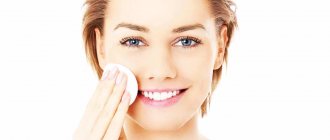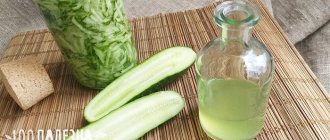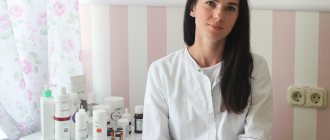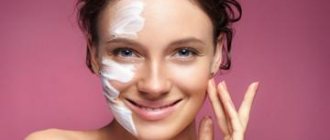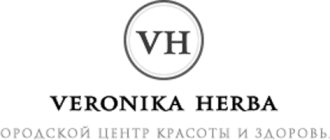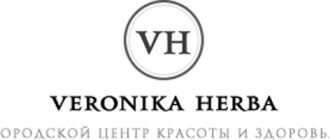Cleansing the epidermal structures of the face and neck is the most important stage of daily care, the implementation of which determines the general condition and external characteristics of the skin.
Cost of services in our clinic
| Appointment with a dermatologist, candidate of medical sciences | 1500 rub. |
| Consultation with a dermatologist (KMS) when removing 2 tumors | 0 rub. |
| Removal of a neoplasm (wart, mole) using the radio wave method | 500 rub. |
| Make an appointment by phone: 8-800-707-15-60 (toll-free) |
| *The clinic is licensed to remove tumors |
This procedure must be carried out correctly; its goal is not only the mechanical removal of decorative cosmetics and impurities that have entered the skin from the environment, but also the deep release of pores from excess sebaceous secretion, which, when accumulated, leads to the appearance of pimples and comedones.
Based on all of the above, it becomes quite obvious that a simple five-minute make-up remover, which most women resort to every day, is not enough to maintain youthful, elastic and healthy facial skin. Cosmetologists recommend dividing classic hygienic facial cleansing into three stages, each of which plays an important role.
Stage I – make-up removal
Makeup removal involves removing decorative cosmetics mixed with secretions from the sebaceous and sweat glands. The procedure should be carried out when there is a feeling of discomfort caused by cosmetic compositions, or in the evening hours, before bedtime. The correct choice of makeup remover must be made taking into account your skin type and its sensitivity.
- Cosmetic milk -
effectively removes cosmetics, and also moisturizes and nourishes the epidermal structures, which makes it possible to use this group of products for dry skin, as well as when age-related changes appear. - Cream -
this product will be the best choice for people suffering from peeling or tightening of the skin, as cream restores the water balance of tissues. - Makeup remover gel –
gel-like structures are designed for those with oily skin with enlarged, contaminated pores and comedones. - Oil is
a gentle cleanser that is suitable even for sensitive, irritation-prone skin.
Stages of facial skin care
Cleansing
Skin care for any type begins at this stage.
The procedure must be carried out 2 times a day: morning and evening. After waking up, you cleanse your skin of sebum and bacteria and prepare it for applying cream and makeup. In the evening, in addition to excess sebum and germs, you cleanse your face of dirt and dust that has settled during the day, and decorative cosmetics. Choose milk, foam or gel - the main thing is that they are intended for your skin type. If you have acne, oily shine, or irritation, pay attention to the presence of anti-inflammatory, soothing and sebum-regulating components in the composition. When cleansing your skin, you need to remember several rules:
- - This procedure must be carried out only with clean hands.
- — The water temperature should be room temperature.
- — When washing your face, you don’t need to vigorously rub the skin for a long time; just distribute the cleanser along the massage lines and rinse.
Toning
The tonic will help narrow enlarged pores, prepare the skin for applying a cream or mask, and restore pH balance. Toning also allows you to remove impurities remaining on the skin after makeup removal and washing. In addition, regular use of tonic helps improve complexion and fill the skin with radiance. For problem skin, the toner will help normalize the functioning of the sebaceous glands, dry out inflammation and reduce redness, especially if it contains active ingredients such as tea tree, salicylic acid and sulfur.
Hydration and nutrition
Oily shine on the face often does not indicate increased sebum production, but dehydration. Therefore, for any skin type it is necessary to maintain and promptly restore the hydrolipid balance. Moisturizer should be selected according to your skin type. For example, for oily and problem skin, products with a non-greasy gel-like texture are recommended, containing, in addition to moisturizing components, soothing and anti-inflammatory (aloe extract, chamomile, panthenol), as well as mattifying (zinc, sulfur, kaolin).
Skin nutrition is also of great importance. The function of nourishing creams is to saturate the skin with beneficial substances, restore the epidermal barrier and protect against the negative effects of environmental factors such as wind, frost, high humidity, etc. Pay attention to products rich in vitamins, antioxidants, natural extracts, lipids. During the cold season, give preference to a nourishing cream with a thicker texture.
Peeling
Lack of regular exfoliation leads to a dull complexion, clogged pores with dead skin particles, and an increase in the number of acne. Peeling promotes skin renewal, better absorption of nutrients with additional care, and evens out the microrelief of the skin. On average, the procedure needs to be carried out once a week.
Additional care
Additional care products include face masks, nasal strips, patches, etc. The use of such products allows for a deeper effect on the skin and helps to more effectively and quickly solve a specific problem, such as acne or blackheads. As a rule, additional care products are distinguished by a higher concentration of active substances that penetrate into the deeper layers of the skin and have a prolonged effect. Masks with tea tree oil, zinc, and salicylic acid have proven themselves in the fight against acne. Today there is a large selection of different types of masks, each of which has its own advantages. For example, alginate masks, due to alginate (a component of seaweed), provide intensive skin nutrition and enhance the effect of the active components in the composition. Fabric masks are also popular; they are easy to use, fit tightly to the face and adhere well to the skin, allowing you to do other things at the same time.
Each mask has its own recommendations for use. Most need to be applied 1-2 times a week, some products require course use. A clear advantage of using face masks is that, as a rule, after removing them you do not need to wash your face; it is enough to distribute the remaining composition on your face and let it absorb.
Stage II – cleansing and toning the skin
Cosmetologists and dermatologists unanimously argue that washing cannot be neglected, since most cosmetic compositions for makeup remover require subsequent removal from the facial skin in order to free up the pores.
Most products are removed from the face with water, but cleansing the skin with micellar water, which does not require rinsing, is becoming increasingly popular. After cleansing the skin, dermatocosmetologists strongly recommend using a tonic, and it is better to choose it from the same brand and series as the main cleanser to restore the optimal PH level.
Using special liquid soap for problem skin for washing is only permissible if it is excessively oily; under other circumstances, it can dry out and tighten the skin.
What types of skin care treatments are there?
“How to properly care for your facial skin,” millions of women are interested in. We answer: it is ideal when competent home skin care is combined with regular visits to a cosmetologist. During skincare procedures, the doctor, depending on the age and skin type of the client, selects a program that allows solving a specific problem. Most skin care procedures include: cleansing the skin, light peeling, toning, facial massage (classical, plastic, Jacquet or lymphatic drainage), application of an active concentrate, then a mask. Also, skincare procedures are often performed according to a more accelerated program: peeling, facial massage and, of course, applying a mask - cream, alginate, collagen or Matrigel.
In addition, the price list of many salons separately includes facial massage, which is recommended to be carried out in a course of 10-15 sessions. This massage improves blood microcirculation, strengthens the muscular frame of the face, providing a lifting effect. To enhance the result, concentrates are usually applied under the massage cream. When caring for the face after 40 to reduce wrinkles, a more noticeable effect, of course, will be from hardware or injection methods.
After skincare procedures, a cosmetologist, having diagnosed the skin, can select facial skin care products at home. The effect of properly selected professional cosmetics for facial skin care will be many times higher than from using self-selected mass market products.
In addition to various facial procedures, the price list of salons also usually includes care programs for the skin of the eyelids, neck and décolleté.
Mechanical deep cleansing of the face without the use of chemicals
It is carried out by cosmetologists in 5 stages:
- No. 1. Makeup remover using water-based balms and toners. Moisturizes the skin and prepares it for the procedure
- No. 2. Steaming with a vaporizer to soften the tissue, open pores and enhance the penetration of active ingredients, which are subsequently applied to the skin.
- No. 3. Manual cleansing is carried out by a cosmetologist over the entire face, which allows you to remove dead cells from the surface, open clogged pores and restore skin tone.
- No. 4. After cleansing, a soothing mask is applied to the face, and then, after removing it, a toning cream or compositions are applied. They are necessary to help the skin quickly cope with irritation and recover from mechanical impact on the epidermis.
- No. 5. The final stage of the procedure is the application of a softening cream and compositions with medicinal components and vitamins for additional nutrition and moisturizing of the skin.
This deep cleansing of the face allows you to get rid of problems with uneven complexion, clogged pores, acne and sagging. It is recommended to carry out the procedures in sessions every 1-2 months to achieve maximum effect.
Contraindications:
- Pregnancy and lactation period;
- Severe forms of epilepsy and hypertension;
- Presence of infectious and inflammatory diseases in the cleaning area
- Skin hypersensitivity, the presence of wounds, as well as individual allergic reactions to the compositions.
Why you need to cleanse your face regularly
Every day, impurities accumulate on the surface of the skin and in the pores: dust, decorative cosmetics, sebum, dead skin particles and even remnants of care products. In order to get rid of them, you have at least two reasons:
- They provoke inflammation. An explosive mixture of pollution is an ideal breeding ground for the development of bacteria and, consequently, the occurrence of acne.
- They reduce the effectiveness of skincare products. It is difficult for beneficial components to break through the “mask” of impurities, so creams and serums cannot show their full potential.
- How to understand that your skin lacks cleansing? Believe me, she will “tell” about it herself! Or, more precisely, it will show in the mirror.
Signs of dirty skin
Healthy, clean skin should look smooth, hydrated and radiant (not to be confused with “shiny with oil”). If yours is still far from this ideal, look for the main signs of contamination:
- A scattering of small pimples.
- Dull complexion.
- Black dots.
- Enlarged pores.
- Uneven terrain.
Scrubbing
If you can’t imagine yourself without weekly scrubs, try using folk remedies as peeling. Coffee, sugar, salt, oatmeal or corn flour perfectly exfoliate dead cells - all these products can be easily bought even in the poorest village store. It is better to apply the scrub only to problem areas of the skin - the T-zone and chin.
We hope our recommendations for properly cleansing your facial skin will be useful to you. Take care of yourself and your skin will always be flawless!
Sources:
- Baumann Leslie, Cosmetic Dermatology. Principles and practice, publishing house: MEDpress-inform, 2016
- Habiff Thomas P., Clinical Dermatology. Acne-like and papulosquamous dermatoses, publishing house: MEDpress-inform, 2014
- V.V. Chebotarev, N.V. Chebotareva, M.S. Askhakov, E.V. Bronnikova, Sensitive skin: causes, methods of therapy, journal Medical Bulletin of the North Caucasus, 2015 https://cyberleninka.ru/article/v/chuvstvitelnaya-kozha-prichiny-metody-terapii

